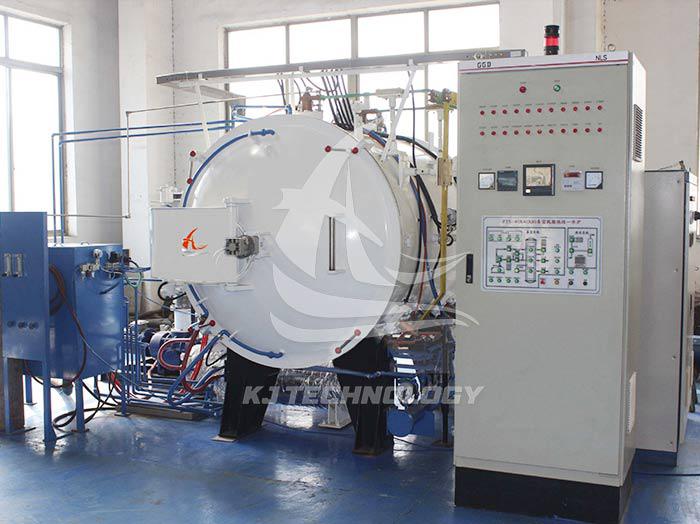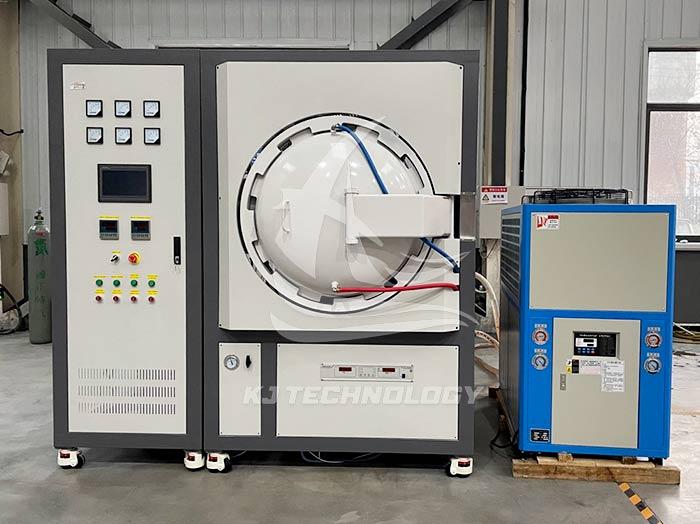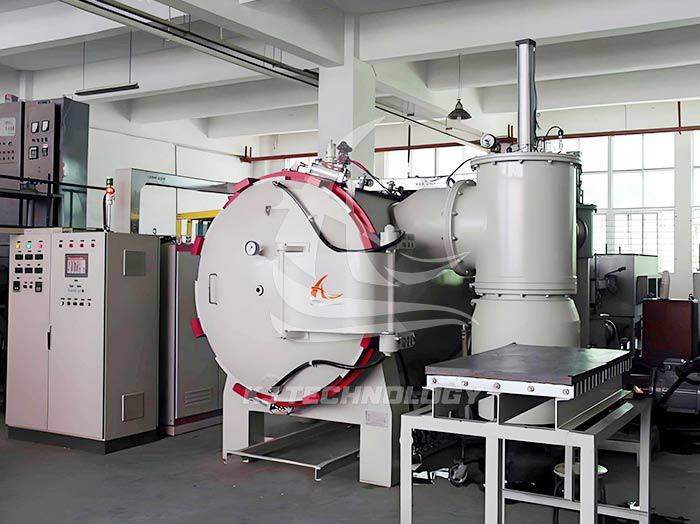What ceramics can be sintered in a customized vacuum furnace for ceramic sintering?
 08-28-2025 Author: KJ technology
08-28-2025 Author: KJ technology
Ceramic sintering customized vacuum furnace, with its high temperature, vacuum or controllable atmosphere environment, can sinter various types of ceramic materials, especially suitable for scenarios with high requirements for purity, density and performance. The following are the main types of ceramics that can be sintered and their typical applications:
1. Oxide ceramics
Aluminum oxide (Al ₂ O3) ceramics
Features: High hardness (Mohs hardness 9), wear resistance, corrosion resistance, good insulation.
Applications: Electronic ceramic substrates, ceramic bearings, seals, grinding tools, artificial joints, etc.
Advantages of vacuum sintering: Avoiding the reaction of alumina with moisture or impurities in the air at high temperatures, improving purity, and achieving density close to theoretical values.
Zirconia (ZrO ₂) ceramics
Features: High toughness, high temperature resistance, good biocompatibility.
Applications: Ceramic cutting tools, oxygen sensors, fuel cell electrolytes, dental implants, aerospace thermal barrier coatings.
Advantages of vacuum sintering: By controlling the distribution of yttrium oxide (Y ₂ O3) stabilizer, the phase transformation toughening effect of partially stabilized zirconia (PSZ) can be achieved.
Magnesium oxide (MgO) ceramics
Features: high melting point (2800 ℃), excellent insulation, and alkali corrosion resistance.
Application: High temperature furnace lining, electrical insulation materials, nuclear reactor structural components, transparent ceramics (requiring high purity).
Advantages of vacuum sintering: prevent magnesium oxide from reacting with CO ₂ at high temperatures to form magnesium carbonate, ensuring material stability.
2. Nitride ceramics
Silicon nitride (Si ∝ N ₄) ceramics
Features: High strength (flexural strength 800-1000 MPa), high temperature resistance (strength does not decrease at 1200 ℃), self-lubricating properties.
Applications: Ceramic bearings, turbine rotors, metal cutting tools, engine components, biological implants.
Advantages of vacuum sintering: Sintering under a nitrogen atmosphere prevents the decomposition of silicon nitride, while promoting densification by adding yttrium oxide (Y ₂ O3).
Aluminum nitride (AlN) ceramics
Features: High thermal conductivity (170-230 W/(m · K)), good insulation, high temperature resistance (decomposition temperature 2450 ℃).
Applications: Electronic packaging substrates, power module heat sinks, LED lighting substrates, surface acoustic wave devices.
Advantages of vacuum sintering: Avoiding the formation of impurities in alumina and increasing thermal conductivity to over 90% of the theoretical value.
Boron nitride (BN) ceramics
Features: High temperature stability (decomposition at 2800 ℃), lubricity, insulation, neutron absorption capacity.
Applications: High temperature crucibles, semiconductor heat dissipation materials, nuclear reactor control rods, cosmetic additives.
Advantages of vacuum sintering: Sintering under nitrogen or argon atmosphere to prevent the formation of boron oxides and maintain material purity.
3. Carbide ceramic
Silicon carbide (SiC) ceramics
Features: High hardness (Mohs hardness 9.5), high temperature resistance (strength does not decrease at 1600 ℃), corrosion resistance, high thermal conductivity.
Applications: Grinding wheels, grinding tools, bulletproof armor, nuclear fuel particle cladding, semiconductor devices, high-temperature bearings.
Advantages of vacuum sintering: Sintering under argon atmosphere prevents oxidation of silicon carbide, while suppressing abnormal grain growth by adding boron carbide (B ₄ C).
Titanium carbide (TiC) ceramics
Features: High hardness (Mohs hardness of 9-9.5), good wear resistance, high temperature resistance (melting point of 3160 ℃).
Applications: Cutting tools, molds, wear-resistant coatings, medical implants (requiring biocompatibility modification).
Advantages of vacuum sintering: Sintering under vacuum or argon atmosphere to avoid titanium oxidation, while promoting sintering densification by adding nickel (Ni).
Tungsten carbide (WC) based hard alloy
Features: Ultra high hardness (HRA 89-93), excellent wear resistance, strong impact resistance.
Applications: drill bits, milling cutters, mining tools, molds, rollers.
Advantages of vacuum sintering: Sintering under low-pressure hydrogen or vacuum environment prevents oxidation of cobalt (Co) binder phase and improves alloy toughness.
4. Boride ceramics
Zirconium diboride (ZrB ₂) ceramics
Features: Ultra high melting point (3245 ℃), high temperature oxidation resistance, and good thermal shock resistance.
Applications: Ultra high temperature structural materials (such as space shuttle nose cones), electrode materials, wear-resistant coatings.
Advantages of vacuum sintering: Sintering in a boron atmosphere or under vacuum to prevent component segregation caused by boron volatilization, while adding silicon carbide (SiC) as a second phase to enhance toughness.
Titanium diboride (TiB ₂) ceramics
Features: High hardness (Mohs hardness 9-10), corrosion resistance, good conductivity.
Applications: Electrolytic aluminum electrodes, wear-resistant components, cutting tools, bulletproof materials.
Advantages of vacuum sintering: Sintering under vacuum or argon atmosphere to avoid titanium oxidation, while increasing density through hot pressing process.
5. Functional ceramics
Piezoelectric ceramics (such as PZT)
Features: Mechanical energy and electrical energy are converted to each other, with high sensitivity.
Applications: Ultrasonic transducers, piezoelectric sensors, buzzers, filters.
Advantages of vacuum sintering: preventing component segregation caused by lead (Pb) volatilization, ensuring the stability of piezoelectric properties.
Magnetic ceramics (such as ferrite)
Features: high resistivity, low eddy current loss, adjustable magnetic properties.
Applications: Transformer cores, microwave devices, recording heads, electromagnetic shielding materials.
Advantages of vacuum sintering: avoiding the formation of iron oxide, improving magnetic permeability and Curie temperature.
Transparent ceramics (such as YAG, MgAl ₂ O ₄)
Features: High transmittance (visible light transmittance>85%), high temperature resistance, high strength.
Applications: laser windows, high-pressure sodium lamp tubes, transparent armor, optical lenses.
Advantages of vacuum sintering: Sintering under ultra-high vacuum (≤ 10 ⁻⁴ Pa) eliminates pores and impurities, achieving optical grade transparency.
6. Composite ceramics
Ceramic based composite materials (CMC)
Types: Carbon Fiber Reinforced Silicon Carbide (C/SiC), Silicon Carbide Fiber Reinforced Silicon Carbide (SiC/SiC).
Applications: Hot end components of aircraft engines, rocket nozzles, brake discs, and first walls of nuclear reactors.
Advantages of vacuum sintering: Through chemical vapor infiltration (CVI) or polymer impregnation cracking (PIP) processes, dense bonding between fibers and matrix can be achieved in a vacuum environment.
Metal ceramic composite materials
Types: Titanium based ceramics (TiC Ti), nickel based ceramics (Ni Al ₂ O ∝).
Applications: Wear resistant coatings, cutting tools, molds, biomedical implants.
Advantages of vacuum sintering: Sintering under vacuum or inert atmosphere prevents metal oxidation and promotes interface bonding between metal and ceramic.








